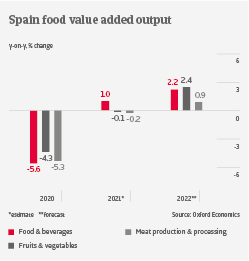Recovery of food demand from hospitality remains shaky

Spanish food & beverages value added output is forecast to grow by about 2% in 2022, after increasing 1% in 2021 and a 5.6% contraction in 2020. Retailers recorded a significant increase in sales and margins in 2020 and early 2021, but the situation has returned to normal with the easing of restrictions, leading to stronger competition and tighter margins. Food services has partly recovered since H1 of 2021, due to rebounded demand from hospitality after the lockdowns (tourism-related hospitality is a key customer of the Spanish food & beverages industry). However, the recovery remains shaky, due to the ongoing spread of the omicron variant.

Producers and processors across all main subsectors are facing high prices for commodities (e.g. for animal feed and metals for food canning), fertilisers and energy. Price negotiations with wholesalers and retailers have started in H2 of 2021, but is seems improbable that higher input prices can be passed on entirely, due to the market power of large retailers. Therefore, we expect margins of food producers and processors to shrink in 2022.
After a significant drop in sales in 2020 the beverages segment has rebounded, but not yet to pre-pandemic levels. The fruit and vegetables segment mainly consists of small businesses with weaker financials compared to other sectors, and is strongly impacted by higher prices for fertilisers and energy. That said, rising exports partly offset the issue of high input prices. In the meat subsector, an excess of pork meat due to recently imposed import barriers from China has led to sharply decreased price levels. This, together with higher energy and feed costs, has led to deteriorating margins for producers.
Payments in the sector take about 60 days on average, and the amount of payment delays and business failures was low in 2021. However, we expect that higher cost pressure, deteriorating margins and the gradual expiry of government support could result in increasing payment defaults and insolvencies in the course of 2022. Mainly affected would be those smaller businesses that have increased their debts during the pandemic. Along subsectors, meat and food services face higher credit risk.
Documenten

915.0KB PDF
